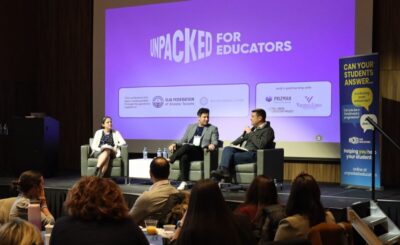A version of this article by Dr. Noam Weissman was originally published in The Jewish Journal. Reprinted with permission.
In the middle of a meeting with my colleague, the talented Adam Teitelbaum, he paused and looked at me on Zoom, and said, “I just miss being a kid.”
Indeed, there has been a search for the mythical Fountain of Youth, which Herodotus mentioned 1,500 years ago. The pursuit to return to our youth can be perceived as shallow and superficial: we don’t want our skin to wrinkle and we get anxious when our hairline begins to recede or our hair greys. This version of the Fountain of Youth is enticing, but it is not the one I am referring to, and I am positive this is not what Adam had in mind either.
Rebbe Nachman of Breslov tells the following famous parable.
“I am a turkey,” said the prince. “I’m also a turkey,” answered the sage.
They sat together like this for some time, until they became good friends. One day, the sage signaled the king’s servants to throw him shirts. He said to the prince, “What makes you think that a turkey can’t wear a shirt? You can wear a shirt and still be a turkey.” With that, the two of them put on shirts.
After a while, the sage again signaled and they threw him pants. As before, he asked, “What makes you think that you can’t be a turkey if you wear pants?”
The sage continued in this manner until they were both completely dressed. Then he signaled for regular food, from the table. The sage then asked the prince, “What makes you think that you will stop being a turkey if you eat good food? You can eat whatever you want and still be a turkey!” They both ate the food.
Finally, the sage said, “What makes you think a turkey must sit under the table? Even a turkey can sit at the table.” The sage continued in this manner until the prince was completely cured.
In his new magnificent book, “Baderech,” Rabbi Judah Mischel writes that this is a story of “intervention, healing, restoration, and fixing.” This young prince “lost his most precious belonging: his identity, his soul — himself.”
This message resonates and I want to add another potential insight. Prior to the wise man bending down and going under the table, all the doctors were lost, despairing they had no idea how to relate to this young prince. The wise man, however, did something very simple. He bent down and joined him under the table.
5782 is a new year, and all of us in education need to think about how we are going to meet our students “under the table.” Let me explain.
In Bereshit 22:12, the angel of God commands Abraham, “al tishlach yadcha el hanaar,” “do not raise your hand against the boy.” “Do not kill the youth,” referring to Isaac, his son. The Baal Shem Tov offers a profound insight about what this verse means.
For his entire life, Abraham was reared to be a man of hesed. He also had big eyes, and a big vision for how to change the world. He was an optimist. He was a dreamer. He was a man of hesed, of doing good for others. Then, he is given the seemingly unconscionable demand to kill his son.
Someone in that moment could feel cynical, wondering, “What is life worth living for? I’m a man of goodness, and you’re asking me to do this? That’s crazy.” He could think, “The way I grew up, all of the acts of kindness I’ve done, that was all cute and fun, but I am older now, and I see the pains and tribulations of life. I see how much suffering there is. I am done with this whole hesed thing. I’m out.”
Instead, the Baal Shem Tov suggests a new meaning of “Al tishlach yadcha el hanaar.” “Do not raise your hand against the boy (naar)” means, “Don’t get rid of your naarut, your youthfulness. Don’t let go of who you were growing up. How you were raised and who you were then is who you still are. You are still Avraham Avinu, the man of hesed and of dreams.” Even though you went through all this, don’t get rid of your youth and ignore the value of hesed! In this reading, the verse is not referring to Isaac. It is about himself! Don’t obliterate your personality. Don’t obliterate the values of your youth.
And, I would argue in 5782, we can all reacquaint ourselves with our naarut a little more.
How many spouses struggle to retain their youthhood and forget the romance of their relationship? They used to go to sleep cuddling and saying “I love you,” but now their backs are to one another and they barely acknowledge the other.
How many of us see the Torah being passed around the synagogue and ignore it, yet when we’re children, we make a beeline to the Torah just to give it a little kiss before the Torah returns to the ark?
How many of us had fun and adventurous days where we daydreamed and let our imaginations guide us instead of our KPI’s, calendars and schedules?
The Baal Shem Tov’s insight of the need to stay in touch with our own youthfulness is a powerful one. Like Abraham, we have all experienced traumatic events. When we get older, we tend to think we’re more mature and more serious. Too often we can have a disposition of looking down on the values and choices of generations that come after us. But, we can avoid falling into this trap. We can remember that there is always something we can learn from young people.
What does this mean in practice? From a media perspective, instead of berating young people for spending so many hours each day on YouTube, Tiktok and Instagram, let’s consider what we can learn from them. Let’s also think about the benefits of social media and of all the opportunities we have to connect with one another because of these tools. Let’s not only focus on the challenges posed by social media, but let’s also remember the positivity, fun and learning that this technology makes possible. The reality is that 51% of Gen Z gets their news from TikTok, as opposed to 26% of millennials. TikTok has about 700 million users per month, and YouTube has an estimated two billion monthly users.
We have a choice. We can either be the doctors who could not figure out what was wrong with the prince, or we can be like the wise man who went down under the table.
To be sure, there are remarkable dangers to social media. Watch “The Social Dilemma” or consider the question about the link between social media and loneliness. But let’s not lose sight of the benefits and possibilities social media offers as well.
From an educational standpoint, let’s consider the potential advantages of the 30-second TikTok video. “Don’t raise your hand against the youth” can mean, “Don’t think that learning just looks like a 90-minute lecture in an auditorium anymore.” This isn’t about whether social media is “right” or “wrong.” Whether we accept the world of social media or not is irrelevant: it is where young people are. Our tradition has always taught us, “Hanoch li’naar al pi darko,” meaning, “Teach the youth according to their ways.” We must accept and embrace it. Let’s not talk down to young people or tell them they are “wrong”; rather, let’s seek to learn from them.
And, I get it. I love physical books and underlining the pages. But if we want to understand teenagers and university students, we must bend down and spend some time under the table.
As we age, we can become cynical and jaded, and it tarnishes everything. For many of us, life did not go as planned. Rabbi Abraham Isaac Kook (Orot Hakodesh 3:97) artfully articulates Adam’s sin, saying that “he was alienated from his selfhood, for he followed the opinion of the serpent and lost himself…and he could not give a clear answer to the question of ‘Where are you,’ for he did not know his own soul… We shall seek out God our Lord and David our king…We shall seek out our ‘I.’”
G.K. Chesterton, the 19th century British philosopher and writer vividly explains: “Where a six-year-old is excited if someone opens a door in a story and finds a dragon on the other side, a two-year-old is excited enough if someone opens a door.”
As 5782 is ushered in, we can follow R. Kook’s guidance and reunite with our selfhood. We can be like the two-year-old that Chesterton describes and allow ourselves to feel the elation of a surprising and meaningful moment. We can reclaim and activate our youthfulness.
Let’s embrace our relationships with our spouses and remember what it felt like under the chuppah.
Let’s embrace our optimistic youthful selves. Let’s go under the table and spend time with our young people, meeting them where they are.
Let’s follow in the path set forth by God to Abraham and never “strike the youthfulness within ourselves.” To my colleague Adam, I say, we can still be kids too. We just need to spend a little more time under the table.



